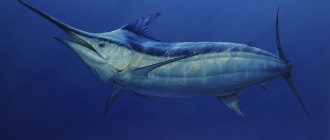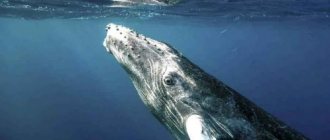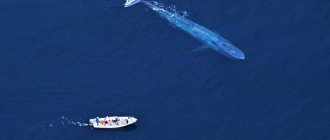17 January112637aquatic inhabitantswhaleslarge
The blue whale or blue whale is a marine animal that is a member of the cetacean order. The blue whale belongs to the baleen whales of the genus minke whales. The blue whale is the largest whale on the planet. In this article you will find a description and photo of a blue whale, you will learn a lot of new and interesting things about the life of this huge and amazing animal.
Minke whale (length 10.7 m)
The whales, with their white bellies, fins, and stripes on their heads, live in small groups; only during the seasonal migration of krill do these whales gather in large populations of up to 100 individuals. They spend the summer in temperate latitudes and move to the tropics for the winter. Found all over the globe.
Tourists love to watch minke whales while hunting: large gray-white animals are very mobile, pirouette like dolphins, jump completely out of the water, and then fall noisily onto the water, raising fountains of spray. Every year, whaling ships catch up to 1,000 individuals in the North, and Japan accounts for up to 90% of the catch. The remaining carcasses go to Norway and Iceland.
Population and species status
Photo: Animal blue whale
Before the extermination by humans, the population grew to hundreds of thousands - according to various estimates, from 200,000 to 600,000 individuals. But due to intensive hunting, the number of vomits has greatly decreased. Exactly how many of them there are on the planet right now is a complex question, and researchers’ estimates vary greatly depending on the calculation method used.
A minimum estimate suggests that there are from 1,300 to 2,000 blue whales on the planet, of which about 300 to 600 animals live in the northern seas. More optimistic researchers give figures of 3,000–4,000 for the northern seas and 6,000–10,000 for the southern seas.
In any case, their population has been severely undermined, as a result of which the vomit whales have been given the status of an endangered species (EN) and are under protection. Industrial fishing is strictly prohibited, and poaching is also suppressed - punishments for notorious poachers have had an effect, and now cases of illegal fishing of blue whales are rare.
Despite this, they are still under threat, and their population is recovering slowly due to the difficulty of reproduction and some other factors:
- ocean water pollution;
- increasing the number of long, flowing networks;
- collisions with ships.
All these are significant problems, for example, in the population of whales studied by scientists, 9% were found to have scars from collisions with ships, and 12% had marks from nets. However, in recent years, a slight increase in the number of blue whales has been recorded, which gives hope for the conservation of this species.
But the population is growing very slowly. In addition to the problems listed above, the reason is also that the niche was occupied by smaller whales, southern minke whales. People did not pay attention to them, which is why they multiplied and now eat large accumulations of krill before the slower and clumsier vomits get to them.
The blue whale's brain is very small compared to other organs - it weighs only 7 kilograms. At the same time, whales, like dolphins, are smart animals; they are distinguished by high auditory abilities. Scientists believe that they are able to send and receive images through sound, and their brain processes 20 times more information than a human.
Northern right whale (length 17 m)
The smooth-skinned inhabitants of the Atlantic reach 100 tons of weight. They differ from their relatives in having a flat back and no fin on it. The average size of individuals is from 13 to 16 meters, females are usually larger than males. The population of northern right whales is small, there are about 300 individuals in the world. Hunting of this species of mammal is prohibited.
White spots often grow on the dark blue head and tail of slow-moving giants - small crustaceans parasitize on the skin, forming large populations. They form hard growths on whales. The northern whale moves at speeds of up to 8 kilometers per hour and makes high-frequency sounds similar to singing and moaning.
Weight record holders
All the titles in this category went to blue whales, but since the giants were caught in the first half of the last century, there is no 100% confidence in the reliability of the measurements.
There is evidence that in 1947, a blue whale weighing 190 tons was caught near South Georgia (an island in the South Atlantic). Based on their oral stories, whalers caught a specimen that weighed more than 181 tons.
This is interesting! So far, the most truthful evidence is the capture in 1926 near the South Shetland Islands (Atlantic) of a 33-meter female puking, whose weight was close to 176.8 tons.
True, evil tongues say that no one weighed this champion, and her mass was calculated, as they say, by eye. One day, luck smiled on Soviet whalers, who killed a 30-meter blue whale weighing 135 tons near the Aleutian Islands in 1964.
Return to content
Humpback whale (length 19.5 m)
The humpback or long-armed minke whale differs from minke whales in having a wide mountain-shaped dorsal fin and narrow side flippers up to 1/3 of the body length. Flexible, agile humpback whales weigh about 50 tons. They have dense, shortened bodies, a flattened head with a protruding jaw. The average length of individuals is up to 17.5 meters.
They live in the subpolar latitudes of the Southern and Northern Hemispheres. The coloring of humpback whales depends on their habitat; there are brown and dark blue individuals with black and white large spots. The coloration is individual, the cubs are born mainly in the summer. While feeding, whales forcefully hit the water with their huge tails, stun the fish, and then scoop them up with their huge mouths like a scoop.
Japanese whale (length 20 m)
Dark mammals are distinguished from other species of right whales by a small dorsal fin located toward the tail. The smooth skin becomes covered with calloused leathery growths with age. The whale has a small head and a mouth with a curved lower jaw. On average, animals reach 18 meters in length and 80 tons. Dense, smooth bodies are overgrown with white spots - crustaceans parasitic on the skin. Females become sexually mature no earlier than 6 years of age; they give birth once every 3-5 years, not more often.
The population of graceful, leisurely whales is small - up to 400 individuals; animals are found only off the coasts of Japan and Mexico. There is a separate Okhotsk population; about 100 females come to the Kamchatka coast to give birth.
Southern right whale (length 20.7 m)
The whale does not have a dorsal fin; its huge head is up to 1/3 of the body length. The average length of individuals is up to 18 years, weight up to 80 tons, cubs are born from 4 to 5.5 meters in length, females are slightly larger than males. Southern right whales live in tropical latitudes. The slow-moving animals that live near the coast received the nickname “right whales” from English whalers. They became easy prey, the carcasses always remained on the surface, and were easy to tow to the shore.
In the last century, when hunting for marine mammals was prohibited, the population of southern right whales increased significantly; there are about 7 thousand animals in the world. The main enemies are killer whales, they hunt for clumsy cubs.
Interesting to know
Among the fish there are record holders in size, weight and behavioral characteristics.
The largest freshwaters include:
- Shilbo catfish: with a growth of up to 3 m, it is capable of growing up to 200 kg or more;
- Mississippi shellfish: with the same height reaches 130 kg;
- giant freshwater stingray: weighs up to 600 kg;
- Chinese paddlefish: weight can reach 300 kg.
In 2005, a giant catfish was caught in the Mekong. Its length reached 2.7 m, weight - 273 kg. This is the largest fish caught by man.
According to many famous chefs, the three most delicious river fish are sterlet, salmon and trout. Some people prefer carp.
The basis of food for river and lake fish is vegetation, insects, larvae, beetles, crustaceans and mollusks. Many fish eat the eggs of other specimens.
Predatory individuals feed on the fry of other inhabitants of the reservoir and smaller fish.
Predatory river fish include:
- pike;
- catfish;
- burbot.
You can also add perch here, but it does not hunt all fish, only small and sedentary ones.
The freshwater world is no less diverse than the marine world. But man, through his production activities, often pollutes fresh water bodies, destroying their inhabitants. You should always remember this. What kind of fish do you like to eat? Share interesting stories that happened while fishing in the comments.
Sperm whale (length 21 m)
The largest species of toothed whales lives throughout the world's oceans. Females are significantly smaller than males, males grow on average up to 19 meters, reaching a weight of up to 50 tons. Unlike other representatives, sperm whales are aggressive; they have more than once tossed boats and small vessels with their rectangular heads. Looking at these mammals, one gains confidence in the conclusions of scientists - they consider hippopotamuses to be the ancestors of whales.
The whale's head is up to 1/3 of the body length. The sperm whale's teeth grow unevenly at the top and bottom. At the top there are up to 3 pairs of huge teeth, weighing up to a kilogram. Below are the remaining 26 pairs, they are much smaller than the top ones. Predators do not disdain sharks and turtles, swallowing their prey whole. In search of food, they dive up to 20 meters.
7Killer whale
The killer whale or killer whale actually belongs to the dolphin family, reaches a length of 10 meters, and its habitat is distributed over all oceans and most seas. One of the longest-living whales, wild killer whales live up to 50-60 years. They boast the second largest brain of any mammal, making them highly trainable, making them popular in swimming pools and aquariums.
Sei whale (length 21.3 m)
A large baleen whale with a pointed muzzle grows on average up to 17 meters and reaches 30 tons of weight. The mobile whale is often called a torpedo; the animal is capable of moving at speeds of up to 25 kilometers per hour, and lives throughout the world's oceans with the exception of near-equator waters. The smooth back is often covered with spots - the consequences of wounds and parasitic lesions.
Females are larger than males, give birth every year, and mate in winter. Whales live in small groups of up to 5 individuals; the calves are breastfed for up to 7 months. This species is distinguished from other baleen whales by a powerful dorsal fin located in the tail part of the body and small pectoral flippers. Mammals are long-livers, living on average up to 75 years.
Nutrition
The diet of blue whales includes plankton, small fish, crustaceans, namely everything that is available in the place where they live. In a day, it is absolutely easy for a blue whale to swallow at least three tons of food. This mammal has no teeth, but it has a mustache that looks like a brush or a large sieve. With the help of such a device, the whale can filter the water taken into its mouth, retaining food. This huge marine animal is unable to eat a human, so the mammal poses virtually no danger to humans. But this baleen whale is still capable of causing harm to humans - it can overturn a medium-sized ship simply by accidentally hitting it.
Bowhead whale (length 22 m)
On average, males grow up to 18 meters, females reach 150 tons. Inhabitants of the cold waters of the Arctic live on average 40 years, although there are long-livers up to 100 years or more. Bowhead whales have good muscle mass. A powerful body makes a path among the ice, throwing itself onto the ice floes.
Every day, each whale eats up to 1.8 tons of plankton, krill, small fish, and filters the prey with its huge curved mouth. An air cavity is clearly visible in the rounded back; whales delight travelers and scientists with powerful fountains. Smooth skin without growths is covered with light or dark spots. The whale is capable of not breathing for up to 40 minutes and dives to depths of up to 200 meters.
Features of character and lifestyle
Photo: Blue whale in the ocean
They often swim alone, and sometimes in twos or threes. In areas rich in plankton, several such groups can gather. But even if the whales are huddled in a group, they still behave detachedly, and after a while they disperse.
You won’t find them close to the shore - they love vast space and depth. They spend most of their time calmly swimming from one accumulation of plankton to another - this can be compared to how land herbivores graze.
On average, a blue whale swims at a speed of about 10 km/h, but can swim even faster - if it is frightened by something, it reaches 25-30 km/h, but only for a short time, since during such a race it spends a lot of energy .
The process of immersion for nutrition is interesting - it requires preparation. First, the whale empties its lungs, then takes a deep breath, dives shallowly about ten times and comes to the surface again, and only then performs a deep and long dive.
Usually the vomit goes into the depths of the water a hundred or two meters, but if it is frightened, it can dive much deeper - up to half a kilometer. This happens when killer whales hunt him. After 8-20 minutes, the whale surfaces and begins to breathe rapidly, releasing fountains into the air.
After “catching his breath” for a few minutes, he can dive again. If a whale is being pursued, it can remain in the water column much longer, up to 40-50 minutes, but gradually loses strength.
Fin whale (length 27 m)
The largest minke whale lives in the subpolar latitudes of both hemispheres in small groups of up to 6 individuals. The second name for the whale is herring. The height of the fountain reaches 6 meters. Maximum speed is 50 kilometers per hour. Females give birth to young annually. They often become prey for sharks. The maximum diving depth is 230 meters.
The shape of whales does not change with age; babies are born a copy of their parents. In proportions, the whale resembles a large fish with an elongated snout. The high dorsal fin adds similarity. Two respiratory channels are clearly visible on the head, the skin is unevenly covered with spots. The fin whale's mouth is pink or white with 360 plates. When diving, the whale bends its tail strongly and can not breathe for up to half an hour.
Blue whale (length 33 m)
The blue whale is the largest whale in the world. This large marine mammal is a long-liver, living up to 100 years. They prefer to live alone, gathering in small groups only for the mating period. The maximum weight of females is 150 tons.
The population of animals is huge, about 10 thousand individuals in the world; they feed on schools of small fish, plankton, and crustaceans. They swallow up to 2.2 tons of food per day. Cubs are born weighing more than two tons, up to 7 meters long, and grow at a speed of up to 4 kilograms per hour. By six months, more than a ton of milk has been sucked out.
The mammal's brain is small, up to 6 kilograms. Blue whales can hear each other at a distance of 1,600 kilometers. The biggest whales and the loudest.
Animals Nature
Origin of the species and description
Photo: Blue whale
Whales, like all other cetaceans, are not fish, but mammals, and descended from land artiodactyls. Their external similarity with fish is the result of convergent evolution, in which organisms living in similar conditions, initially very different from each other, acquire more and more similar features over time.
Of the other modern animals, the closest thing to whales is not fish, but hippopotamuses. More than 50 million years have passed since their common ancestor lived on the planet - he lived on land. Then one of the species descended from it moved into the sea and gave rise to cetaceans.
Video: Blue whale
The scientific description of the vomiting whale was first given by R. Sibbald in 1694, and therefore it was called Sibbald's minke whale for a long time. The now accepted name in Latin, Balaenoptera musculus, was given by C. Linnaeus in 1758. The first part of it is translated as “whale-winged”, and the second - “muscular” or “mouse”.
For a long time, the blue whale was hardly studied, and scientists had little idea even of what it looked like: the drawings in biological reference books of the century before last were incorrect. Only towards the end of the century did the species begin to be systematically studied, and then its modern name, that is, “blue whale,” began to be used.
This species includes three subspecies:
- dwarf blue whale;
- northern;
- southern.
They differ quite little from each other. Dwarf vomits live in the warm Indian Ocean, while representatives of the other two subspecies love colder water and migrate to the Arctic or Antarctic in the summer. Northern vomits are considered the type subspecies, but southern ones are more numerous and larger.
The internal organs were vomited to match the size of his torso - for example, his heart weighs 3 tons. And in the mouth of this whale a medium-sized room could fit.











